Ya: The Yacht that Sailed the World Fossil Fuel Free
Between September 2016 and the summer of 2018, the sustainable yacht “Ya” crewed by Peter Hoefnagels and various guests, sailed around the world without using fossil fuels, proving that even without diesel, petrol and gas it is possible to safely and comfortably sail the world’s oceans.
Published 4 years ago
This Dutch based project was initiated by the Schone Golf (Clean Wave foundation) and sailor and environmental scientist Peter Hoefnagels. With interest in the project growing internationally, the group has started a second circumnavigation, which can be followed on an English language website: www.fossilfreearoundtheworld.org.
In the following article Inge van Berkel gives a tour of Ya, describing the set up and how they sailed her fossil free around the world, often with guests onboard.
Energy Generation

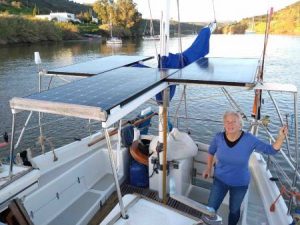
- Solar panels on the Bimini
Let’s start with the three less important things for sailing fossil free: the energy generators (sun, wind and hydro). Later we’ll tell you about the three really important ones.
All electricity on board is generated in 48 volts, because that is the most efficient and easiest to install.
Solar Panels – on the Bimini:
These three panels deliver 720 Watt (peak). They deliver in daylight, not only when the sun is shining. They are thin, the wind cools them well, so, a lot of yield. The solar panels cannot be tilted because of safety issues, because a cruiser must be allowed to be lazy, and because only “off the shelf” products are used in the design.
Solar Panels – on the Deck:

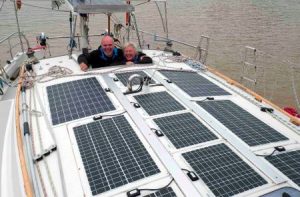
- The solar panels on the deck.
These panels deliver approximately 450 Watt (peak) and not just when the sun is shining. The panels can also be walked on because they are covered in a thick layer and glued to an insulated deck. So when it gets warm, like in the tropics, they produce little. However, when it gets cold like in the winter in Europe, they deliver. During the winter it was 10-15 degrees in the daytime, at night it went down considerably, we even had ice on deck a few times.
Solar Panels – in the Windows:
These panels deliver approximately 40 Watt (peak). They also catch the reflection of light on the water. It does not contribute much, we put them where we can’t look outside anyhow, for example behind the cupboards and anchor box.


- The solar panels in the windows.
Wind Generation

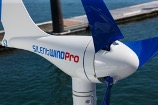
- The SilentWind turbine used on “Ya”.
The wind blows exponentially stronger with more altitude. The turbine on the Ya is on 7 meters. The SilentWind (www.silentwind.com) generator delivers 520 Watt (peak). The low-noise blades make some sound in the low range, when the delivery is small anyway, so we switch it off. From 12 knots it becomes interesting with 50 Watts. At 15 knots you can’t hear them at all, the sound is drowned out by the wind through the rigging.
Generally, on upwind courses the windmill produces nicely, because of the extra wind from your speed. Downwind, you sail your own wind dead so then the delivery is mostly poor.
Autoprops and Dynamos

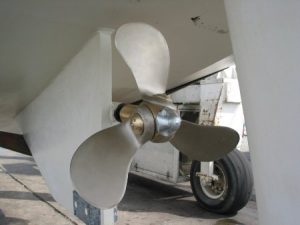
- The Autoprops and dynamos.
Just one switch changes the electric engine in the dynamo function. From about 4.5 knots the Autoprops and dynamos produce the first 30-50 Watts, and then it increases quickly, up to 300 Watts at 7 knots (almost hull speed). This makes them ideal for beam and downwind courses.
Upwind, their drag would cause too much leeway, so we switch the engines/dynamos off and they automatically go into vane position.
There is always some energy coming in thanks to this “energy tripod” of solar, wind and hydro energy.
If it is really foggy and cloudy and no wind for a week, then there is plenty of storage in the battery bank.
Battery Bank

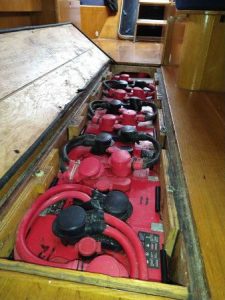
- The battery bank on board “Ya”.
The battery gank stores 55 kWh of electricity, which is made up of 24 lead-acid batteries, together weighing 1.2 tons. The weight is needed for the centreboard design of “Ya”.
These types of batteries require little maintenance and the 55 kWh is normally enough for an average family for a week.
Energy balance: focus on the consumers
Everybody wants to know whether the energy on board is enough. In our experience, it’s about the three really important things for fossil free sailing, living, working and acting:
- use only what you need
- use only what you need
- use only what you need.
Thinking Ahead

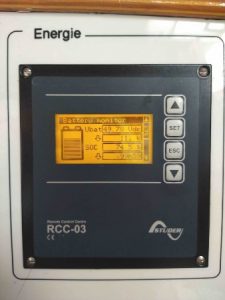
- The Energy Display helps everyone on board keep track of energy consumption
Living with the energy balance requires some “thinking ahead” for how to use the devices that use energy on board.
We found out the behaviour of guests on board of Ya changes. Not because the skipper says so, but because they look at the energy meter.
You see what you use. You see what is generated. You anticipate that. You choose your routing carefully checking the weather and the tide, so you can sail pleasantly.
Sometimes this means you must depart earlier or much later than you thought you would. When you are sailing you are rewarded with the benefits of going fossil free – more safety, more peace and quiet, more comfort.
Inside Ya
Cooking

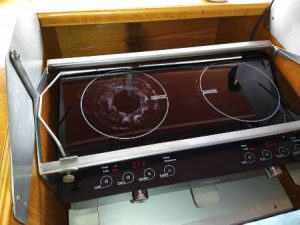
- The induction cooker on Ya.
The double-skinned water cooker only heats the water from the inside. The double skin releases almost no heat. This represents an 80% reduction compared to the old-fashioned gas whistling kettle, where most of the heat is lost to the air that flows along the kettle.
In addition, gas heating produces water vapor, which leads to a humid climate, which feels colder, which increases the heating requirement. Automatically switching off the kettle also reduces consumption, but perhaps the best invention is the scale in the kettle, so that you only use what you need.
Induction Cooker
The induction cooker only heats the bottom of the pan, making it 55% more efficient than gas or regular electric cooking.

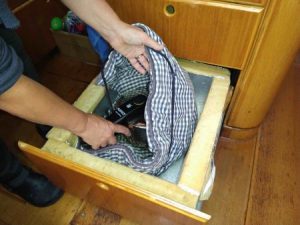
- The Hay Box
Hay Box
In combination with the hay box , 80% of the energy requirement for cooking is reduced. This also brings peace to the galley (fewer pans on the stove, a longer cooking time that is less critical).
Microwave
The microwave only heats what you need. We rarely use the oven because of its inefficiency.
Breadmaker
When we bake bread, we do it with the bread maker which is about three times more efficient.

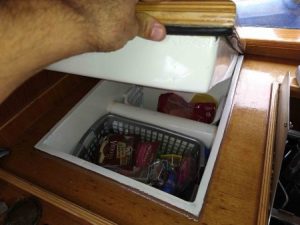
- The cool freeze box.
Cool Freeze Box
We have an extremely well-insulated, top-loading fridge/freezer (10-15 cm thick PIR foam all-around) with the compressor outside – not under the refrigerator. As a result, the smallest compressor on the market (30 Watts) now cools the 25 litre freezer compartment at -11 and the 50 litre refrigerator at +2. This is the standard of a 2 ** rated refrigerator/freezer.
PIR Foam
PIR foam works two times better than standard rock wool or glass wool or PUR foam. 11 cm thick PIR foam is also used to insulate the hull of the Ya. The sun (or daylight) shines through the windows and the insulation holds the heat inside.
This article is being written while on anchor on the river Guadiana in Portugal, with temperatures of 5-10 degrees Celsius at night. All yachts have a stove on and although we have one on board, we still don’t need it.
Engine Room
An engine room without a diesel engine is spacious, clean, doesn’t smell and it is easy to work in – if there is any work to be done.

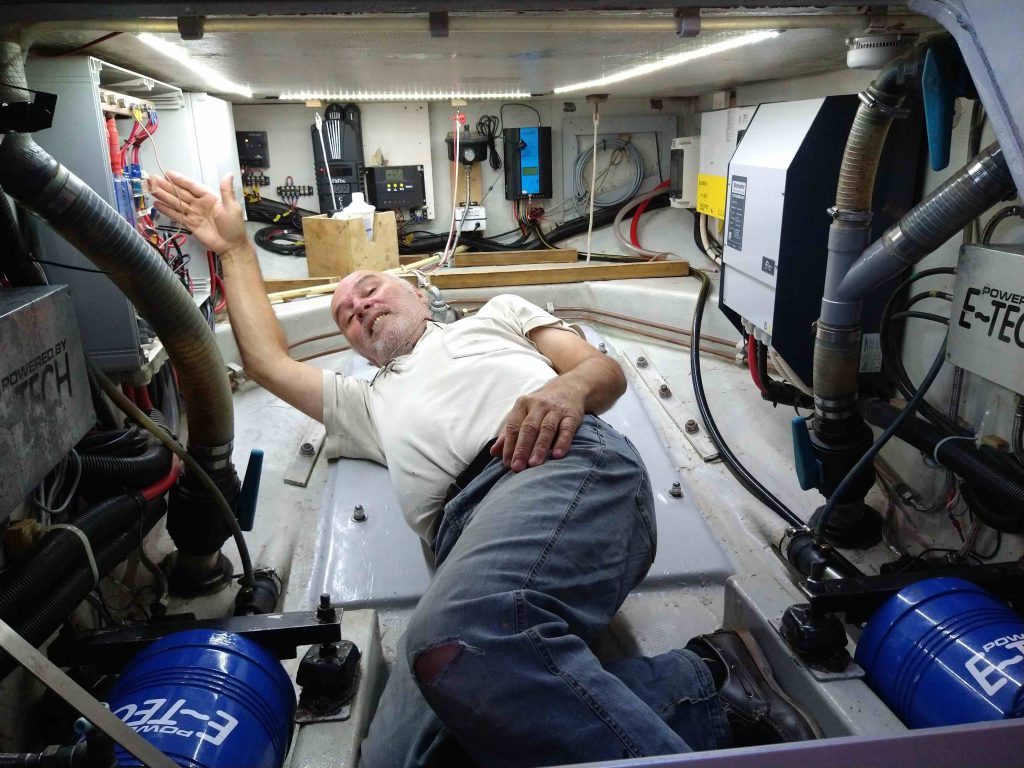
- Peter is pictured inside the engine room.
Propulsion:
The E-Tech engines (www.etechdrives.com) together deliver 13 kW (about 19 HP). The energy consumption and progress depend on the wind and on us. With half throttle without wind on flat water we can sail about 4 knots. But we only use what we need and slowing down a knot saves 50%. We prefer to do that which also gives us peace of mind.
Range and speed:
When we are at sea with no wind, we can do about 2 knots for 48 hours. The consumption curve of the skipper and the yacht is crucial: it rises exponentially as consumption increases.

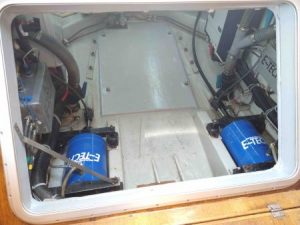
- The blue ‘tin cans’ on each side are the engine dynamos. The controllers are the aluminium boxes above them.
The maximum speed of about 7 knots can only be maintained for 4 hours. We never did this. We are reluctant to use the engine, because we only use what we need. So, we anchor when the tide is against us. And we sail more, which is generally the idea of sailing anyway.
Maintenance:
There is no maintenance on the electric engines/dynamos. Only the batteries occasionally need to be “drained empty”, and “pushed full” with shore power and sometimes they need some demineralised water. All the complexity is in the controller which is the size of half a shoe box and packed with electronics. We always carry a spare one on board.

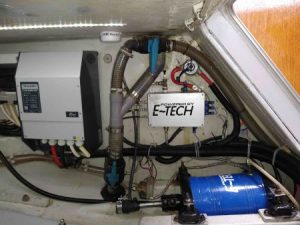
- Ya’s Inverter / converter
Engine Dynamos Inverter Converter:
We have 1 Studer inverter of 6 kilowatts, to make 230Volts out of the 48 Volt battery bank. This is also the converter to get shore power in case we want to maintain the battery bank with the necessary “push full”. There is also a smaller extra converter which can contribute to this “push full”.
Converters:
We have several converters pictured below right:
- 1 for the Bimini top panels (the high one in the picture)
- 1 for the deck panels (right to the high one)
- 1 for the (little) window panels (left to the high one)
- 1 for the SilentWind (most right, with the blue vertical on it)
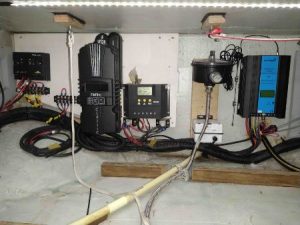

What Can You Do?
I hope you enjoyed this tour of our boat and it encourages you to continue or start sailing fossil free, or at least fossil poor. It is cheaper, it mostly brings more comfort and it brings a nicer state of mind if we try not to compromise the lives of our next generations, our children and grandchildren.
You can do a lot right now. Just use only what you really need will save a lot. A thorough planning of your trips prevents a lot of motoring. Reducing your motor speed and using a sleeping bag for cooking are simple ways to reduce your energy consumption.

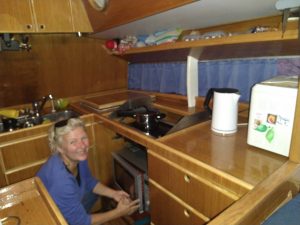
- Writer Inge in the Galley of the “Ya”.
If you want to know more:
- About the ‘Ya’ – check our website: FossilFreeAroundtheWorld . You’ll find articles on the generation issue and the crucial Energy Balance in setting up the yacht to be fossil fuel free.
- About fossil free circumnavigation, see the history section on the website. (If you understand Dutch, then go to www.duurzaamjacht.nl and read all about it)
Or contact us through info@fossilfreearoundtheworld.org
Inge van Berkel – on behalf of Peter Hoefnagels,
……………………………………………………………………………………………………………………………………
Related Links:
- Fossil Free Around the World Website
- The Fossil Free Team
- Electric Boat: What are the options for going electric? (Yachting Monthly July 2020)
Related Reading:
- Electric Shock: Jimmy Cornell Abandons Fully Electric Powered Circumnavigation (December 2020)
- EL.CA.NO. Project: Jimmy Cornell Prepares to Circumnavigate Again (September 2020)
…………………………………………………………………………………………………………………………………..
The opinions expressed in this article are the author’s own and do not reflect the view of Noonsite.com or World Cruising Club.
Related to the following Cruising Resources: Circumnavigation, Cruising Information, Electrics and Electronics, Engines, Environment, Equipment, Wind Generators




Fantastic report and a treasure trove of a website, thanks for that! A few questions if I may: “55 kWh of electricity, which is made up of 24 lead-acid batteries, together weighing 1.2 ton” that’s a huge and heavy battery, especially if you don’t motor all that much. Can you explain your reasoning for sizing it that way? I’m thinking of a much smaller LifePO4 battery that is mostly charged from a large solar array.
How many hours do you motor at around 4 knots? That for me seems a reasonable cruising speed, 2kn would be too slow even for me 🙂
Dear Simon,
Clear that you thought a lot about it, my compliments.
The battery bank is too big, but we could get a governments grant if we would comply with their power boat rules. Forgive my the logic of governments, but it ended up that we saved a lot of lead. (we have a centre board so all intern ballast). Second reason: why not more backup, just in case of? It helped us when the lead acid batteries became old, because the energy content shrank a lot. In stead of doing about 10 hours on 4 knots in the beginning, last year we could only do 5 hours. But with all this silence, we enjoy the environment too much to motor that fast; you will experience in the future there is too much to see and hear to go that fast, so now we are happy with doing 3 knots. Which consumes 2 times less energy than 4 knots.
Now we are renewing the batteries for a set of LiFePO4, like you. This is much smaller. It is effectively 33 kWh. Actually we are happy with 25 kWh, but after 5 years and intensive use we expect them to contain 80%. We can do with 25kWh because the main reason: We use only what we need, which comes down to efficiency. We cook all we want, motor all we want, consume all we want, but we use-only-what-we-need. This saves about 50-80% compared to the regular sailors consumption.
Second reason is that we have various generators: the props-with-alternators, the solar panels and the windturbine. This ‘tripod’ always delivers some energy to rely on. I would recommend to do the same. So do an electric engine that can also charge. You will use it often. It saves battery capacity and it saves stress, brings peace on board 🙂
Dear Simon,
Forgot a main thing, the internal resistance of the lead acid batteries, reduces the energy input to some 80% of what really is generated (from solar, wind, hydro generation). And, when you use the energy from the battery, again the internal resistance costs 20%. 0,8 X 0,8 = 0,64. This makes that the energy efficiency of the lead acid bank is about 65%. But, the LiFePO batteries hardly have internal resistance. It means you don’t have this inefficiency, and loss. So to conclude: if LiFePO4, a smaller bank is sufficient.
Please reply if something is not clear.
Peter
Thank you very much for the reply Inge, apologies for the late reply as I only saw it now.
I purchased a trimaran, and am about to realize a fully-electric boat as well. Much smaller boat obviously so I’ll only have about 7kWh of LiFePo4.
Best regards, Simon